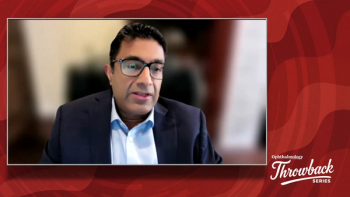
Determining glaucoma progression can be tricky task
Fort Lauderdale, FL-There currently is no accepted standard for determining progression of optic disc defects in patients with glaucoma. However, investigators may have hit upon an approach to make that difficult task easier.
Researchers at Dalhousie University, Halifax, Nova Scotia, and the University of Manchester, Manchester, United Kingdom, have determined that an optic disc depth change of at least 50 μm and the size of a change are important discriminators in patients with glaucoma. Clusters of changes do not have to exceed more than 1% of the disc area to indicate progression in glaucoma.
"When imaging the optic disc, the question that arises is: 'What constitutes an optic disc change that is clinically significant?' " said Balwantray Chauhan, PhD, at the Association for Research in Vision and Ophthalmology annual meeting. "One of the problems in glaucoma that will exist for the foreseeable future is the fact that there is no accepted standard for determining progression of defects of the optic disc."
"In glaucoma, we have a technique that measures changes in the optic disc or visual field changes, but there is no reference standard because the very test or types of tests being used to make the diagnosis of progression are the reference standards themselves," said Dr. Chauhan, professor and research director, department of ophthalmology and visual sciences, Dalhousie University. "So, we in glaucoma are seeking a test that would facilitate the diagnosis of progression or the absence of it."
Alternative approaches
In the absence of such a test, clinicians can compare normal subjects without glaucoma and patients with glaucoma.
"By doing this, we can say that the biggest change that we observe in the normal subjects can be the minimum amount of change that is required when defining progression," Dr. Chauhan said. By considering the maximum amount of change that occurs as the result of aging or other factors in healthy subjects, clinicians have a template by which the diagnosis progression can be facilitated.
Another approach is to look at changes that occur in a positive sense, such as improvements in visual fields or in the structure of the optic disc, and interpret them as noise, according to Dr. Chauhan.
"Any amount of change that exceeds that noise can be interpreted as a progressive change," he said.
Investigators now have two standards by which to measure change (i.e., improvement rates and progression rates, in the controls). In their study, Dr. Chauhan and colleague Paul H. Artes, PhD, of the University of Manchester, considered a variety of different change parameters, both in terms of the extent and the depth of the change in the optic disc and the significance of the change.
"With each of these criteria, we compared our normal subjects and our patients with glaucoma," Dr. Chauhan explained. "The criteria that gave us the biggest separation between the patients and the controls are the ones that we should be using in clinical practice, and that would be the most sensible and practical for detecting change in patients with glaucoma."
Comparison study
The investigators compared images obtained with a Heidelberg Retina Tomograph from 60 healthy subjects and 91 patients with glaucoma. The data from these eyes were analyzed with the Topographical Change Analysis of the Heidelberg Eye Explorer software. The healthy control eyes (n = 60) were followed for a median of 8.2 years and the glaucomatous eyes (n = 172) were followed for a median of 9.3 years.
The size of the largest cluster of superpixels within the optic disc area with a statistically significant change from baseline was derived for height changes of 0, 20, 50, 100, and 200 μm, and Kaplan-Meier analyses were performed for cluster sizes of 1%, 2%, 5%, 7.5%, and 10% of disc area, Dr. Chauhan explained. They compared event rates between the controls and the patients with glaucoma and within the two study groups.
Newsletter
Don’t miss out—get Ophthalmology Times updates on the latest clinical advancements and expert interviews, straight to your inbox.



















































.png)


